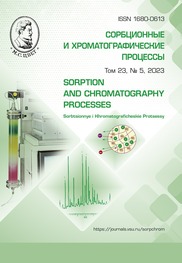Electrical conductivity of heterogeneous ion exchange membranes in solutions of mono-, di- and tricarboxylic acids and its effect on the process of electrodialysis of solutions containing organic acids
Abstract
In this study, the electrical conductivity of cation-exchange and anion-exchange membranes was studied in solutions containing both strong (sodium chloride and acetate) and weak (acetic, succinic and citric acids) electrolytes. The results obtained indicate that the concentration dependence of the electrical conductivity of membranes in weak electrolytes differs significantly from that observed for solutions of strong electrolytes. In the case of an acetic acid solution, the electrical conductivity of the membranes is higher than that of the equilibrium solution over the entire range of concentrations that were studied. It has been shown that existing models of the transport and structural organization of membranes allows describing the structural parameters of ion-exchange membranes in contact with strong electrolytes. In sodium chloride and sodium acetate solutions, the obtained dependences were processed within the framework of microheterogeneous and three-wire models to establish the influence of the nature of the electrolyte on the transport and structural characteristics of the membranes. The dependence of electrical conductivity on the concentration of a weak electrolyte solution does not allow the use of either microheterogeneous or extended three-wire models for the description of the structure-property relationship of ion-exchange materials. It has been shown that in acetic acid and partially succinic acid solutions, the solution provides the main contribution to the resistance of the electromembrane system. Based on the results obtained from measuring electrical conductivity, changes in the design of a laboratory electrodialyzer were proposed and experiments were carried out on desalting a solution of acetic acid. It has been shown that the use of thinner intermembrane separators in the desalting chamber leads to an increase in the integral current efficiency (from 0.32 to 0.44 at 0.6 A/dm2 and the same degree of desalination) and a reduction in specific energy consumption (from 3.0 to 1.9 kWh/mol at 0.6 A/dm2) during desalination of acetic acid. The results obtained can be further used to improve the parameters of the process of obtaining weak acids by bipolar electrodialysis.
Downloads
References
Cournoyer A., Bazinet L. Electrodialysis Processes an Answer to Industrial Sustainability: Toward the Concept of Eco-Circular Economy? –A Review. Membranes (Basel). 2023; 13: 205. https://doi.org/10.3390/membranes13020205
Strathmann H. Electrodialysis, a mature technology with a multitude of new applications. Desalination. 2010; 264: 268-288. https://doi.org/10.1016/j.desal.2010.04.069
Gyo Lee E., Moon S.H., Keun Chang Y., Yoo I.K., Nam Chang H. Lactic acid recovery using two-stage electrodialysis and its modelling. J. Memb. Sci. 1998; 145: 53-66. https://doi.org/10.1016/S0376-7388(98)00065-9
Pleissner D., Schneider R., Venus J., Koch T. Separation of lactic acid and recovery of salt-ions from fermentation broth. J. Chem. Technol. Biotechnol. 2017; 92; 504-511. https://doi.org/10.1002/jctb.5023
Ibeas V., Correia A.C., Jordão A.M. Wine tartrate stabilization by different levels of cation exchange resin treatments: impact on chemical composition, phenolic profile and organoleptic properties of red wines. Food Res. Int. 2015; 69: 364-372. https://doi.org/10.1016/J.FOODRES.2015.01.003
Rozoy E., Boudesocque L., Bazinet L. Deacidification of Cranberry Juice by Electrodialysis with Bipolar Membranes. J. Agric. Food Chem. 2015; 63: 642-651. https://doi.org/10.1021/jf502824f
Moresi M., Sappino F. Electrodialytic recovery of some fermentation products from model solutions: Techno-economic feasibility study. J. Memb. Sci. 2000; 164: 129-140. https://doi.org/10.1016/S0376-7388(99)00186-6
Handojo L., Wardani A.K., Regina D., Bella C., Kresnowati M.T.A.P.A.P., Wenten I.G. Electro-membrane processes for organic acid recovery. RSC Adv. 2019; 9: 7854-7869. https://doi.org/10.1039/C8RA09227C
Sarapulova V., Nevakshenova E., Pismenskaya N., Dammak L., Nikonenko V., Unusual concentration dependence of ion-exchange membrane conductivity in ampholyte-containing solutions: Effect of ampholyte nature. J. Memb. Sci. 2015: 479; 28-38. https://doi.org/10.1016/j.memsci.2015.01.015
Melnikov S., Kolot D., Nosova E., Zabolotskiy V. Peculiarities of transport-structural parameters of ion-exchange membranes in solutions containing anions of carboxylic acids. J. Memb. Sci. 2018; 557: 1-12. https://doi.org/10.1016/j.memsci.2018.04.017
Isaev N.I., Kotov V.V., SHaposhnik V.A. Podvizhnost' organicheskih anionov v anionoobmennyh sisitemah. Elektrohimiya. 1971; 7: 908-911. (In Russ.)
Kotov V.V., Isaev N.I., SHaposhnik. V.A. Perenos slabyh elektrolitov cherez ionoobmennye membrany. ZHurnal Fizicheskoj Himii. 1972$; 46: 539-540. (In Russ.)
Pismenskaya N.D., Melnikova E.D., Rybalkina O.A., Nikonenko V.V. The Impact of Long-Time Operation of an Anion-Exchange Membrane AMX-Sb in the Electrodialysis Desalination of Sodium Chloride Solution on the Membrane Current-Voltage Characteristic and the Water Splitting Rate. Membr. Membr. Technol. 2019; 1: 88-98. https://doi.org/10.1134/s2517751619020070
Melnikov S.S., Nosova E.N., Melnikova E.D., Zabolotsky V.I. Reactive separation of inorganic and organic ions in electrodialysis with bilayer membranes. Sep. Purif. Technol. 2021; 268: 118561. https://doi.org/10.1016/j.seppur.2021.118561
Simons R., Khanarian G. Water dissociation in bipolar membranes: Experiments and theory. J. Membr. Biol. 1978; 38: 11-30. https://doi.org/10.1007/BF01875160
Karpenko L.V., Demina O.A., Dvorkina G.A., Parshikov S.B., Larchet C., Auclair B., Berezina N.P. Comparative Study of Methods Used for the Determination of Electroconductivity of Ion-Exchange Membranes. Russ. J. Electrochem. 2001; 37: 287-293.
Demina O.A., Kononenko N.A., Falina I.V. New approach to the characterization of ion-exchange membranes using a set of model parameters. Pet. Chem. 2014; 54: 515-525. https://doi.org/10.1134/S0965544114070032
Davydov D., Nosova E., Loza S., Achoh A., Korzhov A., Sharafan M., Melnikov S. Use of the Microheterogeneous Model to Assess the Applicability of Ion-Exchange Membranes in the Process of Generating Electricity from a Concentration Gradient. Membranes (Basel). 2021; 11: 406. https://doi.org/10.3390/membranes11060406
Kovalev N.V., Karpenko T.V., Sheldeshov N.V., Zabolotskii V.I. Ion Transport through a Modified Heterogeneous Bipolar Membrane and Electromembrane Recovery of Sulfuric Acid and Sodium Hydroxide from a Sodium Sulfate Solution. Membr. Membr. Technol. 2020; 2: 391-398. https://doi.org/10.1134/S2517751620060050







